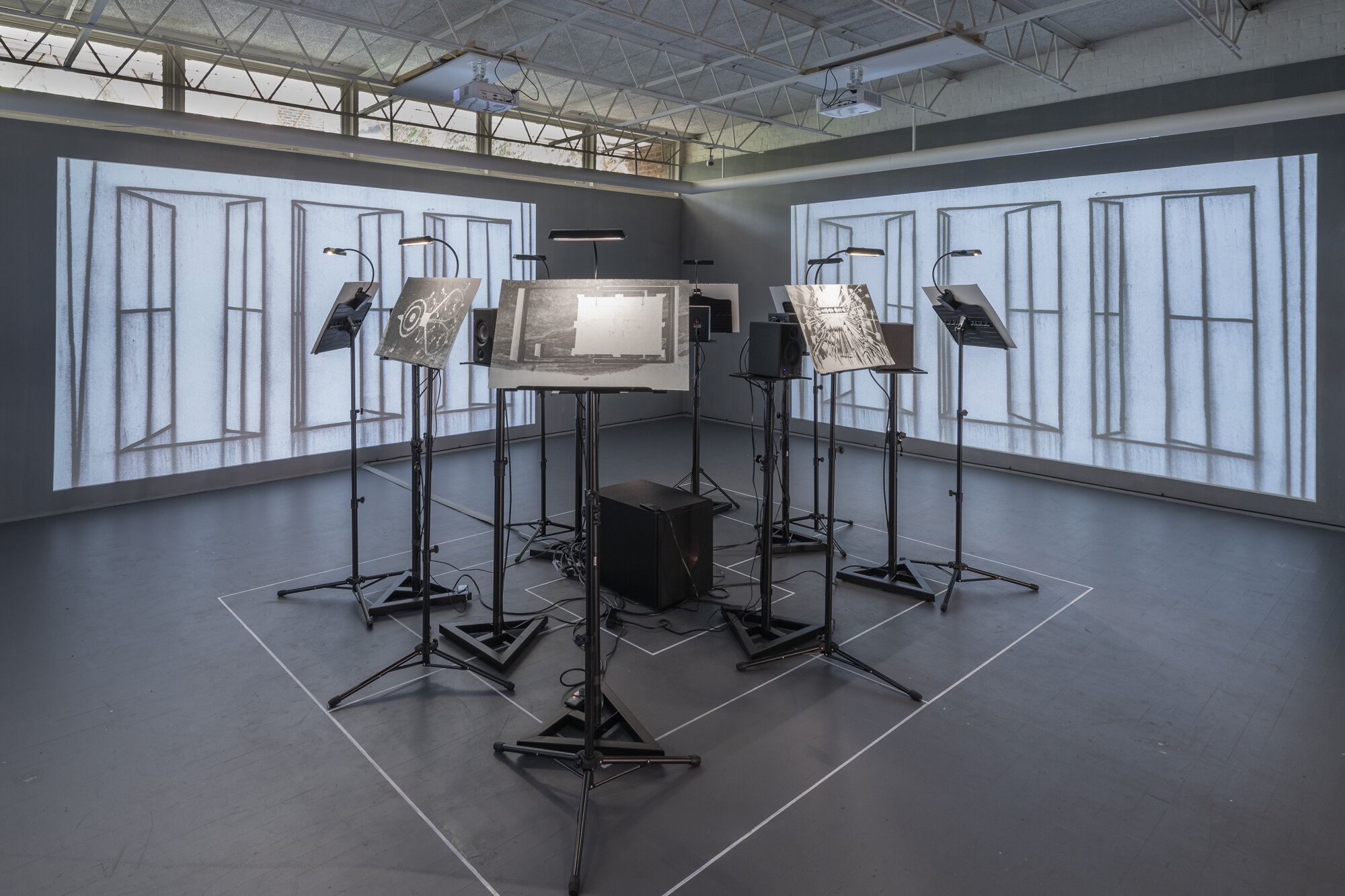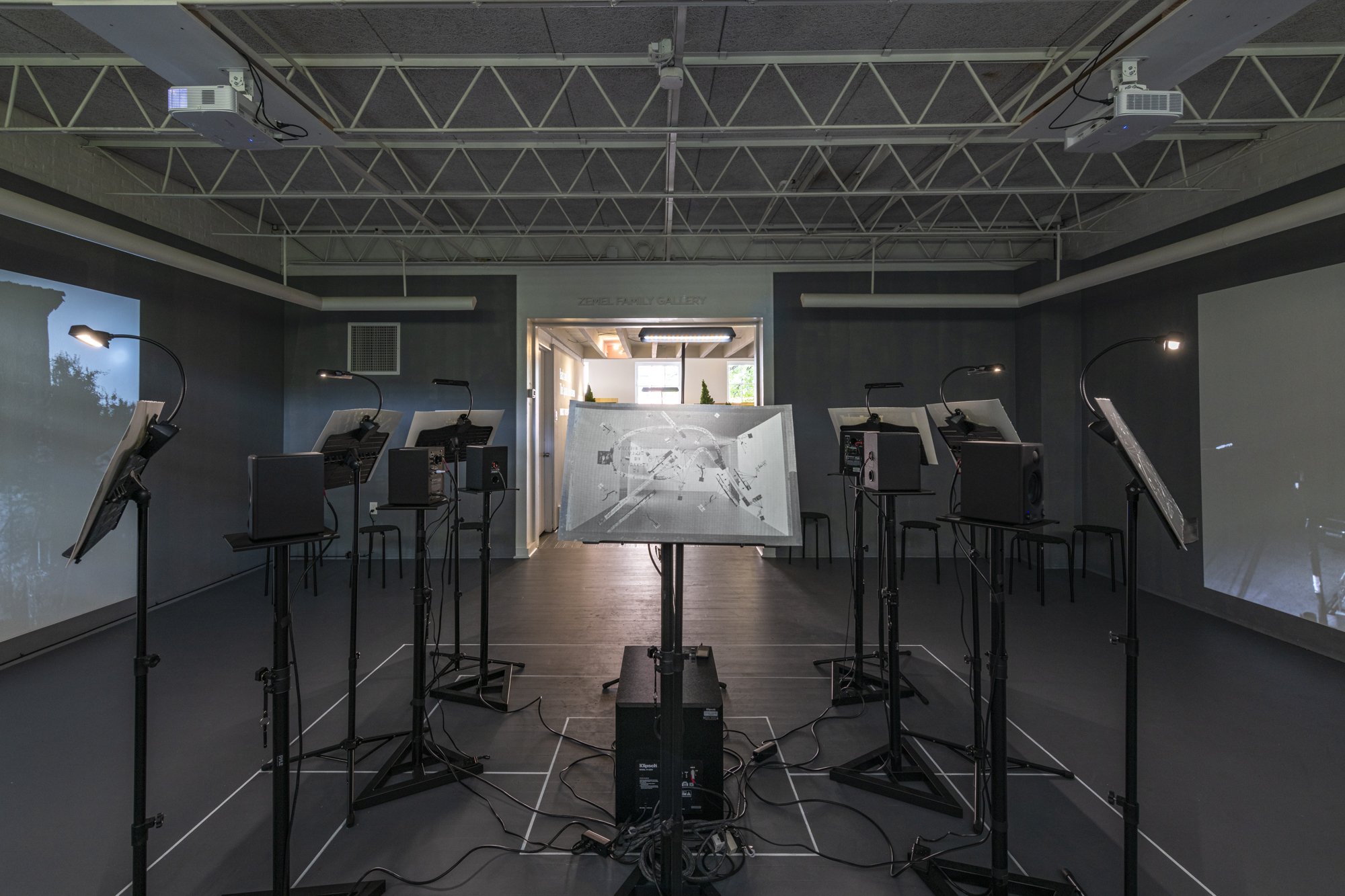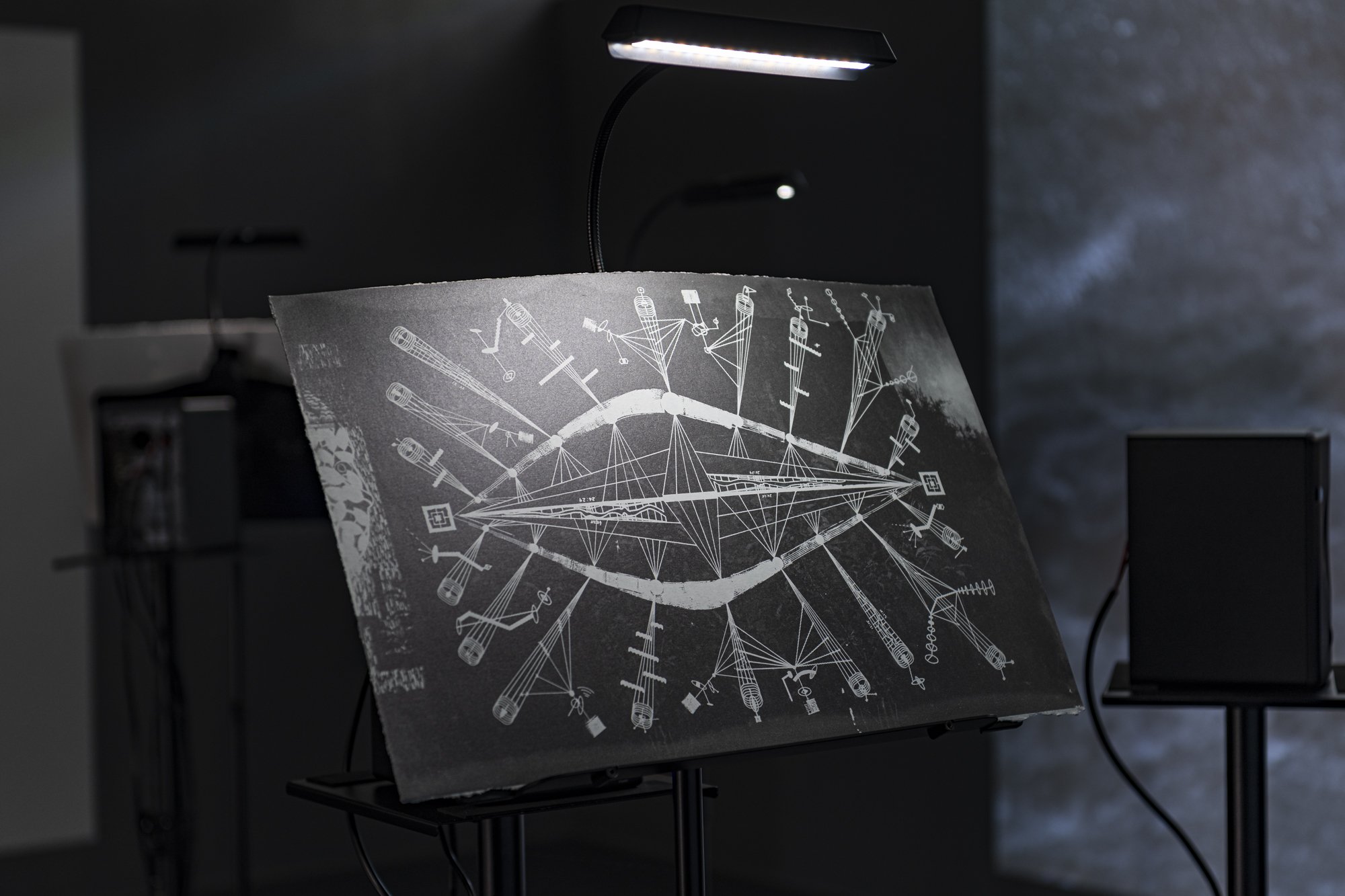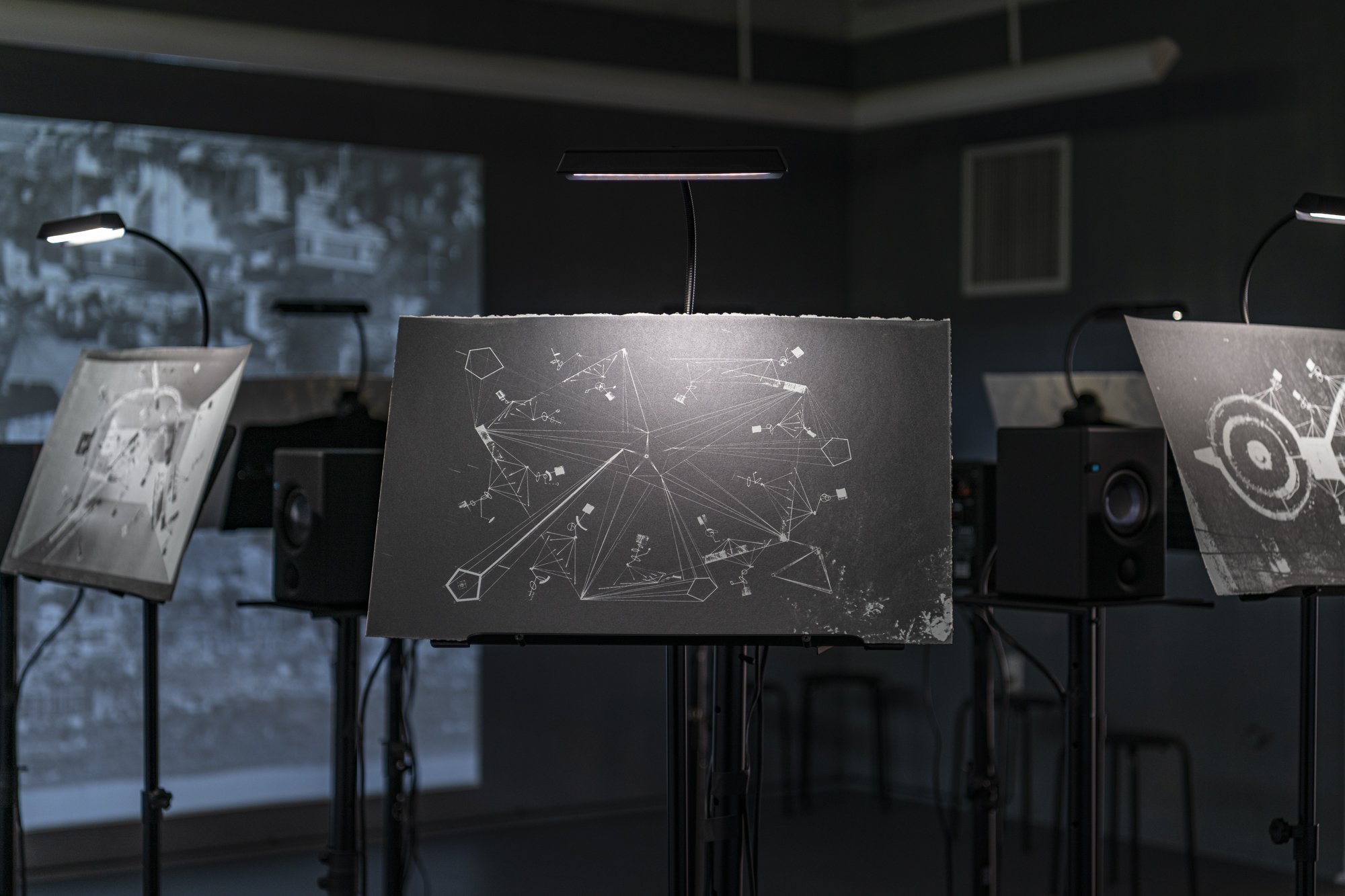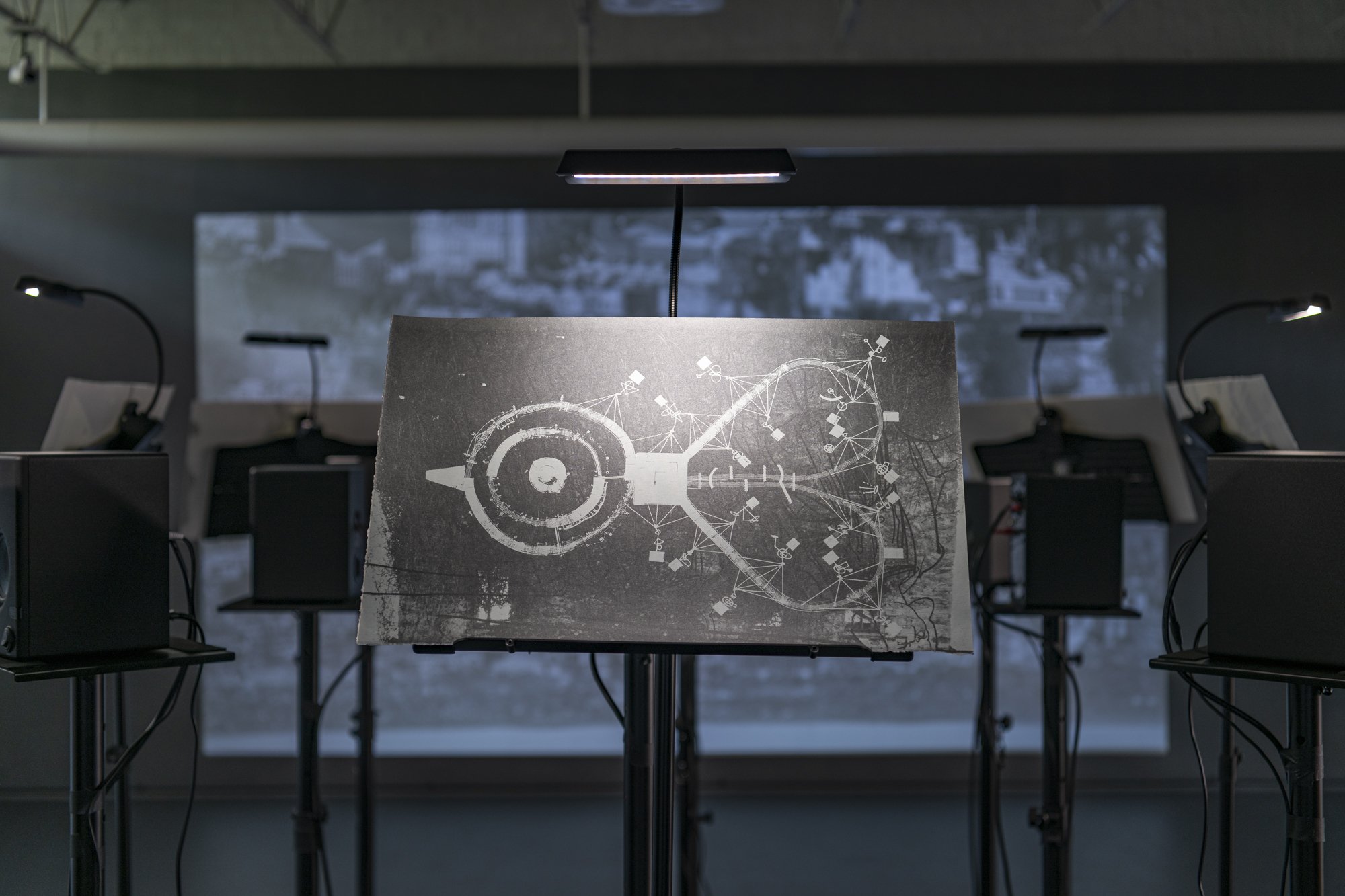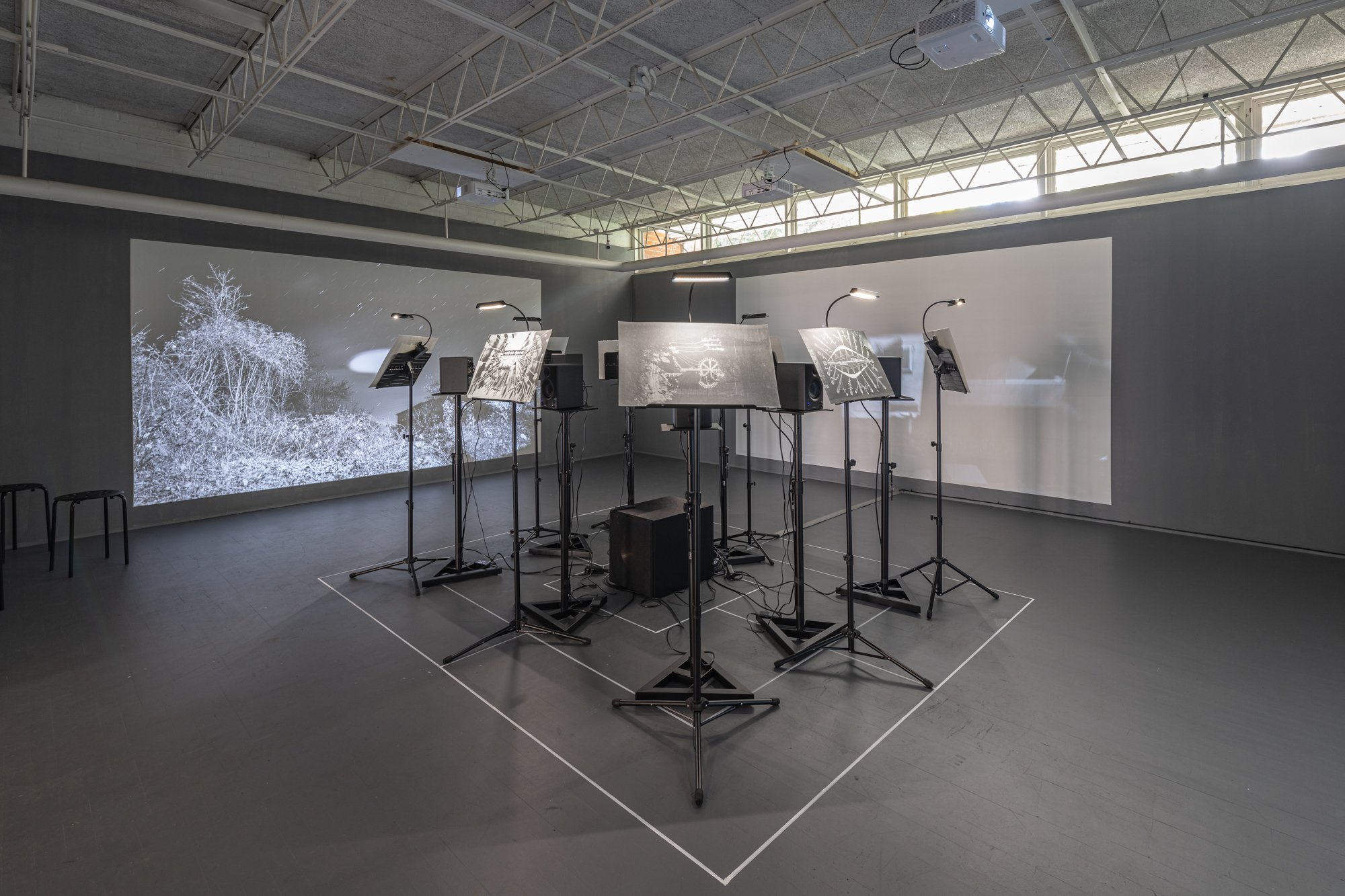
Matriarch with Nine Stones
This work resulted from an ongoing conversation initiated in fall 2018 between Dukovski and me around the lost drawings of Cepenkov, now only available in reproduction. Using Cepenkov’s lost drawings as a departure point, Dukovski and I collaboratively utilize sound and visual strategies to: activate and reimagine part of the lost archive of drawings by Cepenkov; generate metaphors at the intersection of sound, drawing, and architecture through installations that question how to deal with the persistence and erasure of the past, memory, nostalgia, and official histories; and extricate Cepenkov’s work from the jaws of parochial nationalist instrumentalization to facilitate a more imaginative and transnational reading of his work.
The resulting sound, projections, print, photography, and installation were included in Back and Forth: The Space in Between at The Print Center of Philadelphia in the fall of 2021.
For this exhibition project, Dukovski’s work begins by activating Cepenkov’s drawing of a diagram for a children’s game under the name The Matriarch with Nine Stones. This diagram functions as the blueprint for nine other sound compositions by Dukovski, which, performed simultaneously, follow the rules of this particular children’s game to produce a multilayered constellation, much like a symphony. The nine resulting sound works are interpretations of nine other Cepenkov drawings chosen by Dukovski. The children’s game The Matriarch with Nine Stones, sourced by Cepenkov in Macedonia at the turn of the twentieth century, becomes a live performance for two players with two sets of nine stones with two different colors against a diagram hand-drawn onto the ground. Dukovski uses digital technologies and handmade “instruments” to generate sounds that both mimic and respond to various structural characteristics of the subjects depicted in Cepenkov’s drawings. Dukovski studied each element from the past in order to compose each of their sounds in the present, experimenting with his own audio material. Using a mashup of field recordings made during his time spent living in New York, Shanghai, and Ohrid, along with an anthology of mid-twentieth-century recordings of Macedonian folk music, he then generates sound scores that document his process of experimentation. Combining sound and visual form, Dukovski’s sound scores are representations of sound in drawn form that reflect on the material at hand; at the same time, they are artworks in their own right.
Originally from Macedonia, Dukovski currently lives and works in China. After seventeen years as a sound advocate active in the New York music scene, in fall 2019 (and amidst this collaboration), he was issued a ten-year ban blocking his entry to the US. Slated to perform these sound works live at the Print Center, he will instead be physically absent. Aiming to recognize this complication, this project renders his absence present by treating speakers as surrogate performers at The Print Center. Artist and theorist Brandon LaBelle points out that, by extending or restricting the limits of the body, sound is political; further, he explains that from sound we learn about the entanglement of worldly contact, one that extends from bodies and into social formations and politics. Sound, a medium with space-shaping and space-claiming capabilities, transports Dukovski into this space, much like the lost drawings of Cepenkov; sound makes the unheard, heard, the absent, present. In a text piece on “Sound, Place, and Space,” artist Glenn Ligon recalls a statement by Musician and Poet Cecil Taylor who asserts that sound and music also change space itself, transforming a “basement into a citadel, moving the bottom to the top.” Matriarch with Nine Stones, a diagram inscribed onto the gallery floor within this audio-visual project at The Print Center, becomes a meditation on transportation, transformation, and temporality.

This work resulted from an ongoing conversation initiated in fall 2018 between Dukovski and me around the lost drawings of the artist - tailor Marko Cepenkov, who lived from the early nineteenth to the early twentieth century in what was then known as the Ottoman Empire, now only available in reproduction. Using Cepenkov’s lost drawings as a departure point, Dukovski and I collaboratively utilize sound and visual strategies to: activate and reimagine part of the lost archive of drawings by Cepenkov; generate metaphors at the intersection of sound, drawing, and architecture through installations that question how to deal with the persistence and erasure of the past, memory, nostalgia, and official histories; and extricate Cepenkov’s work from the jaws of parochial nationalist instrumentalization to facilitate a more imaginative and transnational reading of his work.
The resulting sound, projections, print, photography, and installation were included in Back and Forth: The Space in Between at The Print Center of Philadelphia in the fall of 2021.
For this exhibition project, Dukovski’s work begins by activating Cepenkov’s drawing of a diagram for a children’s game under the name The Matriarch with Nine Stones. This diagram functions as the blueprint for nine other sound compositions by Dukovski, which, performed simultaneously, follow the rules of this particular children’s game to produce a multilayered constellation, much like a symphony. The nine resulting sound works are interpretations of nine other Cepenkov drawings chosen by Dukovski. The children’s game The Matriarch with Nine Stones, sourced by Cepenkov in Macedonia at the turn of the twentieth century, becomes a live performance for two players with two sets of nine stones with two different colors against a diagram hand-drawn onto the ground. Dukovski uses digital technologies and handmade “instruments” to generate sounds that both mimic and respond to various structural characteristics of the subjects depicted in Cepenkov’s drawings. Dukovski studied each element from the past in order to compose each of their sounds in the present, experimenting with his own audio material. Using a mashup of field recordings made during his time spent living in New York, Shanghai, and Ohrid, along with an anthology of mid-twentieth-century recordings of Macedonian folk music, he then generates sound scores that document his process of experimentation. Combining sound and visual form, Dukovski’s sound scores are representations of sound in drawn form that reflect on the material at hand; at the same time, they are artworks in their own right.
Originally from Macedonia, Dukovski currently lives and works in China. After seventeen years as a sound advocate active in the New York music scene, in fall 2019 (and amidst this collaboration), he was issued a ten-year ban blocking his entry to the US. Slated to perform these sound works live at the Print Center, he will instead be physically absent. Aiming to recognize this complication, this project renders his absence present by treating speakers as surrogate performers at The Print Center. Artist and theorist Brandon LaBelle points out that, by extending or restricting the limits of the body, sound is political; further, he explains that from sound we learn about the entanglement of worldly contact, one that extends from bodies and into social formations and politics. Sound, a medium with space-shaping and space-claiming capabilities, transports Dukovski into this space, much like the lost drawings of Cepenkov; sound makes the unheard, heard, the absent, present. In a text piece on “Sound, Place, and Space,” artist Glenn Ligon recalls a statement by Musician and Poet Cecil Taylor who asserts that sound and music also change space itself, transforming a “basement into a citadel, moving the bottom to the top.” Matriarch with Nine Stones, a diagram inscribed onto the gallery floor within this audio-visual project at The Print Center, becomes a meditation on transportation, transformation, and temporality.
